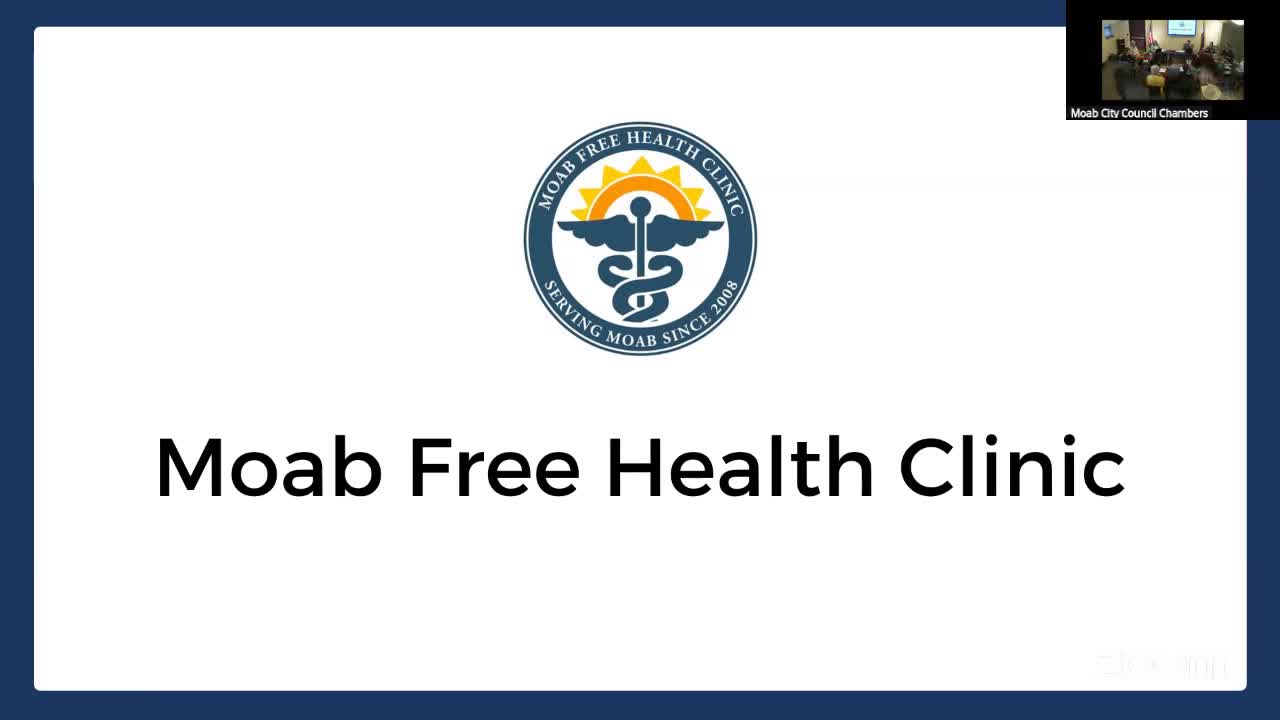Moab Free Health Clinic outlines growing services, asks for city collaboration as costs rise
October 15, 2025 | Moab City Council, Moab, Grand County, Utah
This article was created by AI summarizing key points discussed. AI makes mistakes, so for full details and context, please refer to the video of the full meeting. Please report any errors so we can fix them. Report an error »

Kate Jagla, executive director of the Moab Free Health Clinic, and David Olson, the clinic’s development manager, gave an update to the Moab City Council on Oct. 14 describing service expansion and rising local need.
Jagla said the clinic provided nearly 2,899 appointments in 2024 for about 1,200 individuals and saved patients an estimated $1 million in health-care costs. “Fifty-four percent of our patients work in the hospitality industry,” Jagla said, and about 41% of patients identify as Hispanic or Latino. Jagla told the council that if the Free Clinic did not exist, about two-thirds of its patients said they would either go to an emergency room or receive no care.
Clinic services include primary care, dental, vision, STI testing and prevention (including access to PrEP), and a growing mental-health program that now includes a psychiatric resident rotation from the University of Utah. Dental services are expanding; Olson described recent grants and partnerships that doubled dental capacity and helped the clinic add part-time dental staff.
Jagla said the clinic is building homeless outreach services in coordination with local partners, including weekly outreach, free showers, medication storage and jail outreach aimed at reducing repeat homelessness. Olson and Jagla listed multiple small grants and local donors that help deliver services; they said volunteers are essential but that recruiting and retaining consistent volunteer providers remains a challenge.
Why it matters: Clinic leaders said about 10–12% of the local population relies on the Free Clinic for care and that changes in federal/state funding or insurance markets (including potential Medicaid changes) could increase demand.
Requests and next steps: Clinic leaders asked for continued partnership with the city and local agencies, help with outreach and potential letters of support for state or federal grant applications. Jagla said the clinic already receives some support from the Canyonlands Health Care Special Service District and requested continued coordination.
Ending: Councilmembers thanked the presenters and encouraged council and staff to explore partnerships to support clinic capacity as insurance and funding pressures increase.
Jagla said the clinic provided nearly 2,899 appointments in 2024 for about 1,200 individuals and saved patients an estimated $1 million in health-care costs. “Fifty-four percent of our patients work in the hospitality industry,” Jagla said, and about 41% of patients identify as Hispanic or Latino. Jagla told the council that if the Free Clinic did not exist, about two-thirds of its patients said they would either go to an emergency room or receive no care.
Clinic services include primary care, dental, vision, STI testing and prevention (including access to PrEP), and a growing mental-health program that now includes a psychiatric resident rotation from the University of Utah. Dental services are expanding; Olson described recent grants and partnerships that doubled dental capacity and helped the clinic add part-time dental staff.
Jagla said the clinic is building homeless outreach services in coordination with local partners, including weekly outreach, free showers, medication storage and jail outreach aimed at reducing repeat homelessness. Olson and Jagla listed multiple small grants and local donors that help deliver services; they said volunteers are essential but that recruiting and retaining consistent volunteer providers remains a challenge.
Why it matters: Clinic leaders said about 10–12% of the local population relies on the Free Clinic for care and that changes in federal/state funding or insurance markets (including potential Medicaid changes) could increase demand.
Requests and next steps: Clinic leaders asked for continued partnership with the city and local agencies, help with outreach and potential letters of support for state or federal grant applications. Jagla said the clinic already receives some support from the Canyonlands Health Care Special Service District and requested continued coordination.
Ending: Councilmembers thanked the presenters and encouraged council and staff to explore partnerships to support clinic capacity as insurance and funding pressures increase.
Don't Miss a Word: See the Full Meeting!
Go beyond summaries. Unlock every video, transcript, and key insight with a Founder Membership.
✓
Get instant access to full meeting videos
✓
Search and clip any phrase from complete transcripts
✓
Receive AI-powered summaries & custom alerts
✓
Enjoy lifetime, unrestricted access to government data
30-day money-back guarantee


